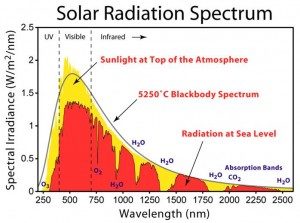UV exposure, aging and our remedy: UV Repair Cream
Sunlight is More than What We See
Ultraviolet light is classified into three categories: UVA (long wave, black light, 315 to 400 nm) which causes tanning, UVB (medium wave, 280 to 315 nm) which causes sunburn, and UVC (short wave, germicidal, 100 to 280 nm) which is filtered out by the atmosphere and does not reach us. Incidentally, the ozone layer absorbs 97–99% of the UV from about 200 nm to 315 nm wavelength, which potentially damages exposed life forms on Earth.

Not everything UV light does to you is bad, ultraviolet light (between 270 nm and 300 nm) reaching our skin breaks down 7-dehydrocholesterol flowing in the bloodstream, converting it into vitamin D. Some experts believe that our efforts to curtail skin damage are pushing us into the area of vitamin D deficiency. Sunscreen and dark skin interfere with your capacity to make vitamin D, but unless you work outdoors, you may not get enough sun even if you don’t wear sunscreen. Talk to your MD, and she/he may measure vitamin D or simply tell you to get a supplement. You will probably need 2,000-4,000 IU, so the 400 or 500 IU in your multivitamins may not be enough. But don’t skimp on sunscreen, because this is unlikely to solve your vitamin D problem (especially if you are dark skinned) and because skin cancer and skin aging are not nice.
It is known that lying in the sun can make you feel good. I am sure this is why I see people lying in the sun for hours, even though they look red and puffy. It can’t possibly be just to show their friends that they have money for a vacation in the sun, right? This “sunbathing addiction” may be related to the release of endorphins as UV reaches our skin. That fleeting sense of well being is not worth the “elephant skin” and, worse, melanoma, which years of sunbathing may bring.
If you are over 50 and had beach vacations, look at the sun-exposed side of your arm: patches of hyperpigmentation, whitish areas where there is little melanin and wrinkles, plus a little scar made by your dermatologist when she excised a dark, menacing looking mole. Now look at the “shaded” side of your arm and you will find mostly youthful, elastic, and smooth skin.
Ultraviolet light stimulates melanin production and the melanin formed absorbs the UV radiation in sunlight, so it protects the cells from further UV damage. However, significant melanin production takes about a week, so during the first day on the beach your skin is fully exposed to the fiery sun, and unprotected by melanin.
Sunburn is a delayed erythema (red skin) caused by ultraviolet B, which induces an increase in blood flow beginning about 4 hours following exposure. The underlying cause of this vascular reaction is damage to the cell from photochemical reactions and the generation of reactive oxygen species. There is damage to DNA, and several inflammatory pathways are activated, particularly involving prostaglandins that ultimately lead to vasodilatation and edema. Sunburn is not only painful, it is also a marker for severe UV damage and a predictor of worse things to come (like skin cancer) within years or decades. Why? There is a correlation between erythema and DNA damage; the UV wavelengths more efficient at producing erythema are also the most effective at forming pyrimidine dimers. There is a link between a history of repeated, severe sunburn and increased risk for melanoma and non-melanoma skin cancer.
Our answer: UV Repair Cream
| Function | Active |
| Skin lightening | Betulinic acid, Niacinamide, Tetrahydrocurcuminoids |
| Antioxidant, Free radical scavenger | Caffeine, Tetrahydrocurcuminoids, Glutathione, Astaxanthin, Lycopene, Alpha-D-tocopherol, Tocotrienols, Lutein, Alpha lipoic acid, Quercetin, Silymarin, Green tea EGCG, Resveratrol, Porphyridium, Myricetin, Ferulic Acid |
| Anti-aging | Resveratrol, Lutein, Astragalus, Porphyridium extract, Myricetin, Silymarin, |
| Anti-inflammatory | Niacinamide, Boswellia serrata, Galangal, Quercetin, Centella asiatica, Ursolic acid, Porphyridium Extract, Mangosteen, Tetrahydrocurcuminoids, Yeast beta glucan |
| Emollients | Shea butter, Rosehip oil, Olive Squalane |
| Skin elasticity | Melatonin, Quercetin, Betulinic Acid |
| Anticancer | Astragalus, Betulinic acid, Niacinamide, Galangal, Lycopene, Silymarin, Mangosteen, Green tea EGCG, Caffeine, Pomegranate seed oil, Sandalwood essential oil, Ceramides, Ursolic acid, Caffeine, Ferulic acid, Black cumin oil |
| Immune function promoter and/or Anti-viral/antibacterial | Beta glucan (yeast), Boswellia serrata, Sea kelp bioferment, Porphyridium extract, Ursolic acid, Galangal, Quercetin, Green Tea EGCG, Astragalus |
| Protease inhibitor | Boswellia serrata, Betulinic acid, quercetin, Ursolic Acid |
| Skin barrier repair | Ceramides, Squalane, Rosehip seed oil, Centella asiatica, Soy isoflavones |
Properties that deserve their own post: stimulation of telomerase activity.
Stimulation of telomerase. I will discuss this very interesting enzyme in a new post. In the meantime, read this.
DISCLAIMER: These claims have not been evaluated by the FDA and are not intended to diagnose, cure, treat or prevent any disease.
